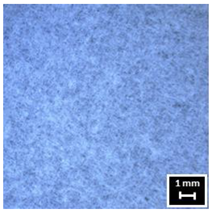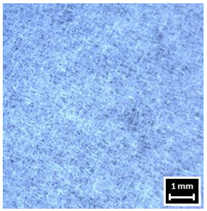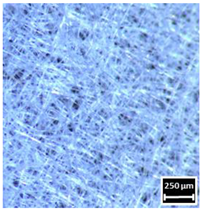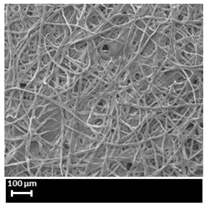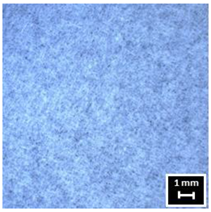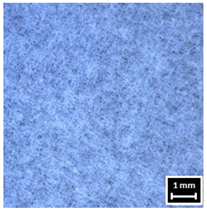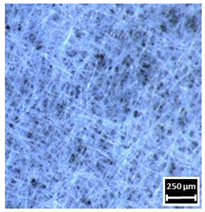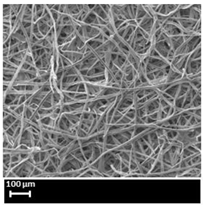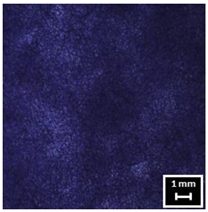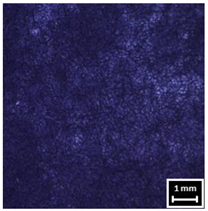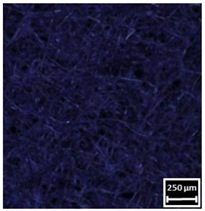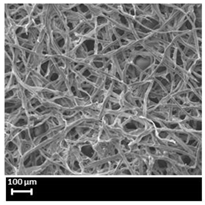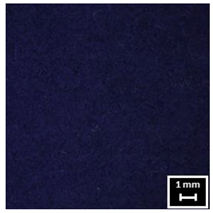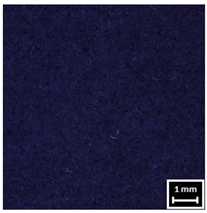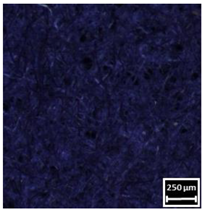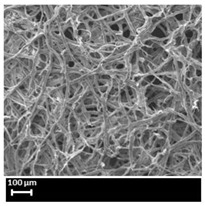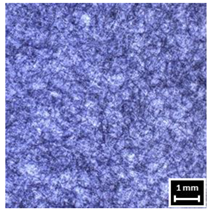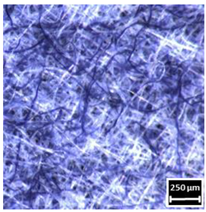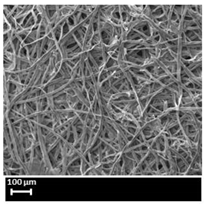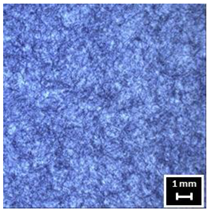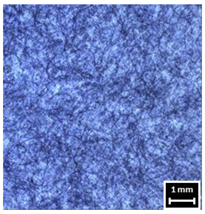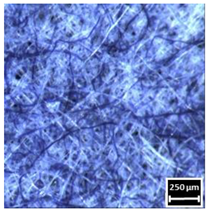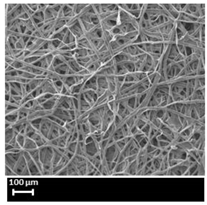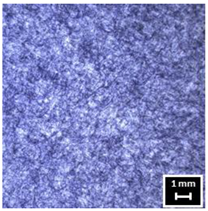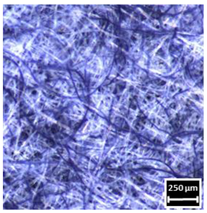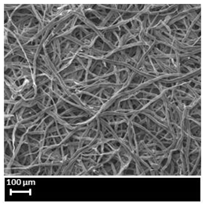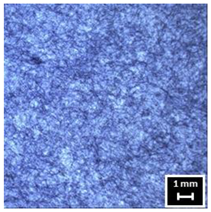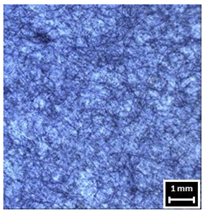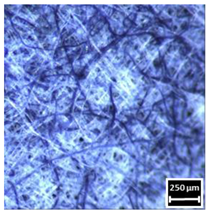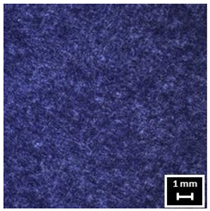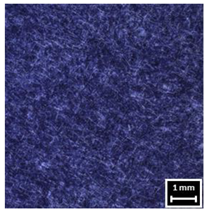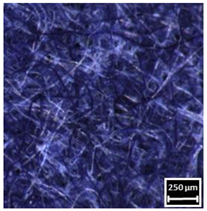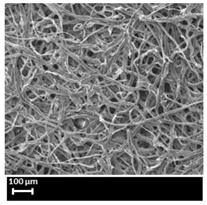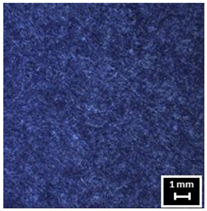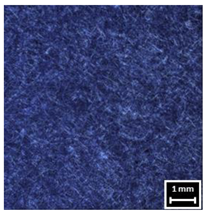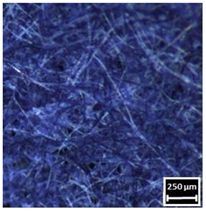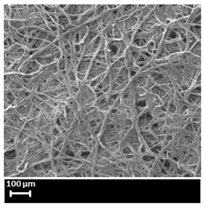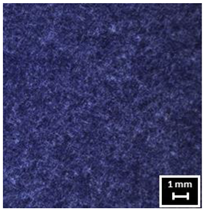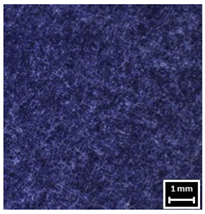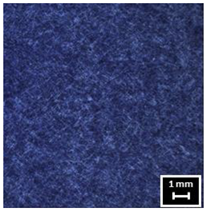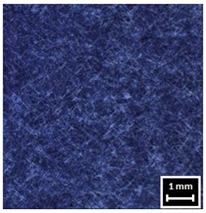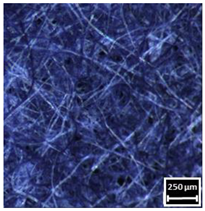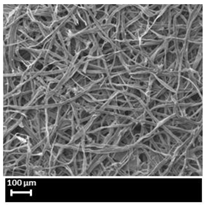Abstract
Due to the continuous optimization of cutting plans, the cotton scrap size resulting from the cutting of components for clothing production (post-industrial residues) is often considered insufficient to obtain fibres with the proper length to produce a new yarn through mechanical recycling processes; so it is important to search for other applications for these wastes. In this context, small pieces of cotton were submitted to a shredding process to obtain recycled fibres. Cotton small pieces and recycled fibres were then submitted to a refining process to achieve refined fibres. Using these materials alone and in blends with refined and unrefined bleached eucalyptus kraft pulp (BEKP), wet-laid nonwovens were developed and characterized. An analysis of the results revealed that the replacement of unrefined BEKP by 70% cotton waste fibres in wet-laid nonwovens, reducing the use of virgin raw material, enhances the structures’ mechanical properties by 80% and 14%, for small pieces or recycled fibres, respectively. Additionally, refining small pieces of cotton seems to be more promising than refining recycled fibres, because less steps are required to obtain wet-laid nonwovens with better mechanical properties. These results highlight the potential of this approach to be explored further for different products and end applications.
1. Introduction
In the textile industry, sustainability is currently at the forefront of strategic planning, product decisions and brand initiatives. The use of sustainable materials, namely recycled materials, including recycled cotton, is a topic of growing interest in the field of circular economy. At the same time, progress towards circularity by businesses, brands, suppliers, manufacturers and consumers regarding this topic has also been constantly growing [1,2].
Cotton signifies a large portion of the textile industry [3] and its production was, in 2021, 24.7 million tonnes, which corresponds to a textile market share of 22% [4]. The cultivation of cotton uses a considerable number of pesticides [5] and has high water consumption [3]. In addition, the production of cotton-based products results in a large amount of post-industrial waste (fabric waste from the manufacture of garments, also called clips or scraps) and pre-consumer waste (finished products that could not be sold or used including default goods or overstock). In fact, post-industrial and pre-consumer wastes are the largest volume of recycled cotton sources [1,2]. Post-consumer wastes are the products that have been worn and are deemed not suitable for re-use [3,6]. Accordingly, it is of vital importance to find solutions for cotton waste reuse and recycling.
The recycling of textiles can be achieved with mechanical or chemical processes. The mechanical process is a textile-to-textile low-impact process that transforms textile waste into usable recycled cotton fibres. Overall, mechanical recycling begins with a size reduction of fabric waste (if appropriate), which is then shredded until a fibrous form is achieved [3]. This process reduces fibre length, which decreases the final product quality, maintaining, however, the degree of polymerization of the polymeric fibres [7]. Specifically, the end-use application will be determined by the obtained fibre quality [2]. The best fibres quality (higher length, uniformity of length and fineness) can be used in the production of textile yarns, later used for knits and woven fabrics for clothing and home textile applications. Several companies have been working on the mechanical recycling of cotton fabrics, aiming to use the obtained fibres in the production of textile yarns, mainly blended with other fibres. To obtain more sustainable solutions, cotton textile waste is also being exploited to produce recycled cellulosic pulp, through chemical processes, to produce new cellulosic fibres (e.g., Refibra™ from Lenzing, Infinna™ from Infinited fibre, Heiq Aeoniq™ fibre from Heiq). In 2017, Lenzing launched Refibra™ Technology which consists of the transformation of cotton scraps from pre- and post-consumer cotton textile waste into recycled pulp and its addition (up to one third) to wood pulp, producing new lyocell fibres.
Due to the continuous effort placed on optimizing the cutting plans, the size of the textile scraps resulting from the cutting of components for clothing or home-textiles production (post-industrial residues) is often considered insufficient to obtain fibres by mechanical recycling processes with the proper length to produce a new yarn with the required mechanical properties and quality. Therefore, alternative applications for these short fibres are required.
Very short-length fibres, which cannot be processed by any spinning technique, are normally used in the production of nonwoven products. The nonwoven industry is one of the most innovative and important branches of the global fibre products industry, having a wide range of applications, ranging from medical products to geotextiles. The production of the nonwoven involves three main stages, which can be continuous or not: web formation, consolidation and finishing. It begins with the formation of a web, through the deposition of the material on a surface, followed by the bonding of the web, by chemical, thermal or mechanical processes [8].
Wet-laid is an example of web-forming techniques. Different processing technologies exist for this method, depending on the material type, characteristics and properties of the desired solution. The nonwovens produced by this technique can be applied in several areas, namely in hygiene, medical, food industry, filtration, construction, electrical energy and electronics industries, geotextiles and upholstery. Fibre length, orientation and diameter, density and porosity of the structure among other properties determine the specific application of the nonwoven [8,9,10,11,12,13].
In the wet-laid process, fibres are dispersed in water at a very high dilution, deposited on a moving wire screen and drained to form a web. The forming wire is often inclined to facilitate removing high amounts of water and avoiding machine direction (MD) fibre orientation. The web is dewatered, consolidated and dried, resulting in a uniform, largely isotropic sheet. Raw materials for wet-laid include short synthetic fibres and wood pulp [8,9,10,11,12,13].
In 2019, it was reported that petroleum-based materials accounted for around 70% of the raw materials used in the nonwovens industry [14]. Therefore, efforts are being made to use more eco-friendly and renewable raw materials, while producing higher-performance nonwoven products.
Cotton fibres have been successfully used in the production of tissue paper for different applications, providing higher softness, strength and thickness [15]. In fact, the absorption capacity, softness and high wet strength of cotton fibres, along with its biodegradability, make cotton an ideal candidate for the production of nonwovens for medical and cosmetic applications, for example [16,17]. Several studies report the incorporation of cotton in the production of nonwovens via wet-laid [18,19] and air-laid [20,21,22] processes. Additionally, the cotton fibres can be blended with other natural-based materials, such as wood pulp, to improve the properties of the resulting nonwoven fabrics [16,21]. For instance, Farer et al. (1998) was able to develop wet-laid nonwovens using blends of cotton fibres and softwood pulp fibres (in a 50/50 proportion) [18].
Recently, the recycling of cotton waste and its use in the production of nonwovens has gained more interest [23,24]. However, the blend of cotton textile residues with wood pulp fibres to produce wet-laid nonwovens has not been explored so far, to the best of our knowledge.
In the present study, different matrixes of cotton waste-based fibres were obtained from cotton waste straps. The recycled cotton fibres were further blended with bleached eucalyptus kraft pulp (BEKP) in a 30/70 and 70/30 proportion to produce wet-laid nonwovens. The resulting structures were characterized regarding their basis weight, thickness and bulk. Mechanical properties, such as stretch at break and tensile index, and softness were examined as well, which are important for practical applications. Additionally, the samples were morphologically analyzed, and moisture management properties were assessed.
2. Materials and Methods
2.1. Materials
Blue cotton knitted fabric waste, obtained from the cutting of components for clothing manufacturing (post-industrial waste) was provided by a Portuguese textile company. A bleached eucalyptus kraft pulp (BEKP) in the form of bale pulp was selected for this study from a Portuguese pulp mill.
2.2. Preparation of Cotton in Small Pieces and Fibres from Cotton Fabric Waste
The blue cotton fabric waste was cut into small pieces with variable geometry and size (approximately 1–4 cm width and 1–4 cm length) by a cutting machine, which has a rotary cutter with a 50 cm width and adjustable cutting length. The small pieces were then shredded in a tearing line with 2 sections and 100 cm width to obtain mechanically recycled fibres.
2.3. Characterization of the Fibres from Small Pieces and Mechanically Recycled Fibres
Cotton fibres removed from the cut pieces of cotton underwent comprehensive characterization, encompassing measurements of linear mass, tensile strength, elongation and tenacity. The length characterization procedure conformed to the specifications outlined in NP 1874:1982 [25], employing a substitution of the glass plate with a velvet surface coated surface. Linear density measurements were made in compliance with EN ISO 1973:2021 [26], while assessments of tensile strength and elongation were conducted in accordance with the guidelines outlined in EN ISO 5079:2020 [27]. The same methodologies were applied to mechanically recycled fibres to facilitate comparative analysis.
2.4. Preparation of Cotton Fibre Suspension from Cotton Waste
The previously obtained cotton fibres could be processed via wet-laid technologies. Nevertheless, the obtention of cotton fibre suspensions by refining the blue cotton waste in small pieces and the obtained mechanically recycled fibres were also evaluated. These suspensions can be used to mix directly with the wood pulp via wet-laid processes. Thus, two matrixes of cotton waste were subjected to pre-extraction with water at 40 °C (to prevent foam formation), with a minimum of 12 h of hydration. After this step, the hydrated waste was slowly added to a standard laboratory Valley refiner and kept in refining until the obtention of a homogeneous cotton fibre suspension, according to ISO 5264-1 [28]. The method consists of passing a cotton waste suspension between the rotor bars and the stator of a Valley refiner. The obtained cotton fibre suspension was centrifuged and was used in the production of the nonwovens at a lab-scale, via wet-laid processes. The refining process was evaluated for cotton fabric wastes cut into small pieces, which required 40 min of refining, and mechanically recycled cotton fibres, which required 20 min of refining (Figure 1).

Figure 1.
Centrifuged cotton fibre suspension after refining of cotton waste in small pieces (left); refining of mechanically recycled cotton fibres (middle) and centrifuged cotton fibre suspension (right).
2.5. Development of Recycled Cotton Waste Fibres/BEKP Nonwovens, via Wet-Laid Processes
For nonwoven production via wet-laid processes, cotton waste-based fibres as described in Section 2.2. and Section 2.3. were used, as well as BEKP in the form of bale pulp. The nonwovens were produced from recycled cotton waste fibres alone as well as in blends with refined and unrefined BEKP in the ratio of 30/70 and 70/30. Initially, 30 g (oven dry) of each fibre group were hydrated for at least 4 h and disintegrated according to ISO 5263-1 [29] at 30,000 revolutions. Refined BEKP was obtained using a PFI mill, according to ISO 5264-2 [30], followed by disintegration at 10,000 revolutions. In the PFI mill method, the pulp is beaten between a roll with bars and a smooth beater housing, both rotating in the same direction, but at different speeds. After, each suspension was diluted in approximately 8 L of deionized water. Each consistency (amount of fibre per volume of suspension) was determined according to ISO 4119 [31]. The structures were prepared with a basis weight of 20 g/m2 according to an adaptation of ISO 5269-1 [32], without couching, resorting to a conventional sheet former (LABTECH, Sorisole, Italy).
2.6. Characterization of Recycled Cotton Waste Fibres/BEKP Nonwoven Structures
The samples were conditioned at 23 ± 1 °C and 50 ± 2% relative humidity, according to ISO 187 [33]. Nonwovens were characterized by basis weight (ISO 12625-6 [34]), thickness and bulk (ISO 12525-3 [35]). The basis weight was obtained by the quotient between the average mass of each structure and the respective area. The apparent thickness was obtained using a Frank-PTI micrometer. The bulk was calculated by dividing the apparent thickness per the basis weight. Mechanical properties were determined according to ISO 12625-4 [36] using the tensile strength (N/m) normalized by the basis weight, yielding the tensile index (Nm/g) and stretch at break (%). The softness was analyzed in tissue softness analyzer (TSA) equipment (emtec, Leipzig, Germany). Furthermore, a morphological analysis of the fabricated nonwoven samples was conducted employing two distinct techniques: digital microscopy (magnification: ×15; ×25; ×120) and Scanning Electron Microscopy (SEM) (magnification: ×200).
Finally, the moisture management properties of the nonwovens were estimated according to the AATCC TM195-2017 [37] standard using a moisture management tester (MMT) (SDL Atlas®, Hong Kong). All samples were conditioned for at least 24 h before being tested. The MMT functions were measured, such as wetting time (s) (time in seconds when the top and bottom surfaces of the specimen begin to be wetted after the test is started), absorption rate (%/s) (average speed of liquid moisture absorption for the top and bottom surfaces of the specimen during the initial change of water content during a test), wetted radius (mm) (greatest ring radius measured on the top and bottom surfaces), spreading speed (mm/s) (the accumulated rate of surface wetting from the centre of the specimen where the test solution is dropped to the maximum wetted radius), one-way transport index (difference between the area of the liquid moisture content curves of the top and bottom surfaces of a specimen with respect to time) and overall moisture management (index of the overall capability of the sample to transport liquid moisture as calculated by combining the measured attributes).
The results obtained during the test can be converted to grades as defined in the standard, following the table below (Table 1).

Table 1.
Grading table of all indexes, according to AATCC TM195-2017e3 [37].
2.7. Analysis of Biometric Properties of Refined Cotton Waste Fibres
A complementary analysis of the biometric properties of refined cotton waste fibres was performed, using the fibre analyzer L&W Fibre Tester Plus (ABB Group, Kista, Sweden). The morphological characteristics yielded and analyzed from the Fibre Tester Plus includes fibre length, fibre width, fibril area, fibril perimeter, fines, coarseness, curl and kink index.
3. Results and Discussion
The revalorization of cotton fabric waste is receiving more attention. Previous studies have reported the production of regenerated cellulose fibres from cotton waste [38,39]. For instance, Björquist et al. developed lyocell fibres from pure cotton waste pulp and blending with birch-based kraft dissolving pulp [38].
In the present study, blends of cotton fibre waste and wood pulp were explored for the development of nonwoven structures. As such, in this work, the blend of cotton waste-based fibres with BEKP pulp resulted in nonwovens with different properties.
The nonwoven production via wet-laid processes, which is conceptually more similar to papermaking, could result in paper-like structures. Thus, in this work, lower basis weight (gsm) structures, without pressing, were produced, allowing one to obtain more flexible structures.
The results obtained from the characterization of the cotton fibre waste are shown in Table 2.

Table 2.
Cotton fibre waste characterization.
Despite their macroscopic differences, cotton fibres from small pieces and mechanically recycled cotton fibres share several similarities in their physical characteristics. Both samples possess comparable lengths and linear densities, suggesting similar fibre thickness. Nevertheless, there was a variability observed in the size distribution (Figure 2 below), which shows that for the mechanically recycled cotton fibres, the majority of the fibres have sizes between 16 and 29 mm, while for the fibres from small pieces, this variation ranges from 20 to 28 mm. While there are slight variations in tensile strength, both materials exhibit relatively close average values, with fibres from small pieces at 4.44 cN and mechanically recycled cotton at 4.63 cN. Moreover, their elongation average values are also comparable, with fibres from small pieces demonstrating 6.5% and mechanically recycled cotton fibres slightly higher at 7.1%. These similarities indicate that despite being distinct materials at macroscopic scale, both cotton fibres from small pieces and mechanically recycled cotton offer comparable physical properties. Furthermore, the length characterization test facilitated the conclusion, drawn from the analysis of the fibre distribution histogram, Figure 2, that the textile waste utilized comprises a significant proportion of small fibres (lower than 24 mm). This observation suggests low efficiency in yarn-production processes.

Figure 2.
Cotton fibre length distribution: (A) mechanically recycled cotton fibres; (B) cotton fibres from small pieces.
Figure 3 shows the properties of the structures produced from refined cotton waste in small pieces blended with BEKP. The effect of BEKP refining in the nonwoven properties before blending with cotton was also studied. As reference, structures consisting of 100% refined BEKP and 100% unrefined BEKP were also produced. Bulk and softness were higher for 100% unrefined BEKP, but these properties decrease when blending with refined cotton waste fibres. Moreover, the results show that the structures produced from blends of refined cotton waste fibres/unrefined BEKP had higher bulk when compared to structures produced with the same proportion of refined BEKP pulp. On the other hand, stretch at break and tensile index increase when refined cotton waste fibres are blended with refined BEKP, rather than unrefined BEKP, due to additional points of interaction established between fibres.

Figure 3.
Physical-mechanical properties’ evaluation of structures produced from blends of refined cotton waste in small pieces/BEKP, via wet-laid processes.
The refining of fibres results in a phenomenon called fibrillation, in which fibrils appear at the surface of the fibres. Consequently, interactions between fibres increase and mechanical properties, such as tensile index, are increased [40]. On the other hand, bulk tends to decrease after refining, as the fibre wall becomes thinner.
Mechanically recycled cotton fibres were also refined, and nonwoven structures were produced from blends of these fibres with unrefined and refined BEKP, via wet-laid processes. The properties of the resulting structures were evaluated as previously mentioned and the results obtained are shown in Figure 4.

Figure 4.
Physical-mechanical properties’ evaluation of structures produced from blends of refined mechanically recycled cotton fibres/BEKP, via wet-laid processes.
The properties of the structures produced with this matrix show the same tendencies as the refined cotton waste in small pieces. Bulk is higher for nonwoven produced from refined recycled cotton fibres blended with unrefined BEKP, when compared with structures produced with blends of refined BEKP. However, stretch at break and tensile index were higher for structures produced with refined BEKP.
Figure 5 and Figure 6 show the rearranged results of the physical-mechanical properties of the nonwovens produced, allowing us to better understand the impact of using the two different cotton waste matrixes in blends with unrefined and refined BEKP, respectively. Comparing refined cotton waste in small pieces with refined mechanically recycled cotton fibres, the use of small pieces resulted in higher tensile index, but lower softness (Figure 5 and Figure 6). Nevertheless, the refining time was twice as long, which might explain these results, due to the higher level of defibrillation of cellulosic fibres.

Figure 5.
Physical-mechanical properties’ evaluation of structures produced from blends of refined cotton waste fibres/unrefined BEKP, via wet-laid processes.

Figure 6.
Physical-mechanical properties’ evaluation of structures produced from blends of refined cotton waste fibres/refined BEKP, via wet-laid processes.
In order to better understand the results of the physical-mechanical properties, the biometric properties were analyzed on refined cotton waste in small pieces and refined mechanically recycled cotton fibres (Figure 7).

Figure 7.
Biometric properties of refined cotton waste in small pieces and refined mechanically recycled cotton fibres.
This analysis showed that the samples studied have high curl (deviation of the fibre from its linearity). It is well known that this property has a negative effect on tensile index because it affects the ability of the fibres to bond with each other [41]. On the other hand, refined cotton waste in small pieces has a higher count of fines, which can fill in the void spaces between fibres and improve bonding [40]. Thus, the fines present in this matrix suppress the negative effect of curl and the tensile index is higher compared with refined mechanically recycled cotton fibres. Additionally, coarseness is higher for refined mechanically recycled cotton fibres. Coarseness represents the weight per unit fibre length. Generally, fibres with higher coarseness result in a less bonded structure, with higher bulk and softness, as the wall is thicker, and the fibres are less likely to collapse and bond with other fibres. Refined cotton waste in small pieces revealed lower coarseness, which means that the fibre wall is thinner, and that the fibres tend to collapse and provide a larger bonded area [42].
The morphological evaluation of the manufactured nonwoven material involved a conjugation of two different analytical techniques, as shown in Table 3. The utilization of a digital microscope using different magnifications facilitated the observation of the uniform fibre distribution across the samples, including the samples containing cotton waste. Additionally, this analytical technique allowed one to distinguish between mechanically recycled cotton fibres and BEKP fibres. SEM analysis provided a more detailed view of the fibre morphology and distribution.

Table 3.
Morphological analysis of the structures produced from 100% refined and unrefined BEKP and 100% refined cotton waste fibres via wet-laid processes.
Typically cotton fibres exhibit loose well-defined threads at their ends, which consist of its macrofibrils. In the samples consisting of 100% cotton, it is observable that the surface exhibits non-uniformity, with certain areas displaying a higher concentration of material than others. As previously mentioned, refined cotton fibres have high curl, which affects the bonding ability of fibres and raises the porosity of the produced structures. This fibre deformity is easily observable in the structures consisting of 100% cotton (Table 3). BEKP fibres include different types of cell fibres such as libriform cells, ray cells, tracheids or vessels. These last are the easiest to identify due to their larger dimensions and small punctuations filing their structure, visible in Table 3.
In blends comprising 70% BEKP and 30% cotton waste fibres, interactions between fibres are evident, playing a crucial role in determining the final mechanical properties of the structure. BEKP contributes to improved sample uniformity, thereby fostering a more homogeneous structure. These results are evident in the images displayed in Table 4.

Table 4.
Morphological analysis of the blended structures obtained from refined and unrefined BEKP (70%) and refined cotton waste fibres (30%) via wet-laid processes.
Similar findings can be drawn from the images acquired for the blends consisting of 30% BEKP and 70% cotton waste fibres, as detailed in Table 5. However, in this instance, an increase of void spaces is verified, resembling the observations made for the samples composed entirely of cotton (Table 3).

Table 5.
Morphological analysis of the blended structures obtained from refined and unrefined BEKP (30%) and refined cotton waste fibres (70%) via wet-laid processes.
The moisture-management properties of the different studied nonwovens were also evaluated to understand if the addition of cotton fibres could enhance the nonwovens’ properties. In this technique, the water is sprayed on the top surface of the sample, and its transmission to the bottom is measured; the bottom is initially dry and starts becoming wet after the water is transmitted from the top to the bottom surface. Although this methodology is applicable to knit and woven fabrics, being used to access their thermal comfort and efficacy in the transport of moisture to the fabric’s external surface, the application to the produced nonwovens could highlight their potential application.
Analyzing Table 6 and Table 7, it is possible to conclude that all the studied nonwovens are very hydrophilic, whereas spreading of the water drops on the total area of the measuring system has occurred. As seen in the tables, all samples achieved a wetted radius of 30 mm, which is a response of the fast absorption rate, attesting the hydrophilic nature of the samples.

Table 6.
Moisture-management properties of the nonwovens.

Table 7.
Moisture-management properties of the nonwovens (continuation).
The absorption rate, in terms of percentage of wetted area per second, was higher than 60%, showing a good absorption capacity, and occurred in about 2 s of wetting time. Simultaneously, the spreading speed varied between 7 and about 10 mm/s. Overall, there are not considerable differences regarding the top and bottom studied parameters of the nonwovens. The accumulative one-way transport index expresses the difference between the area of the liquid moisture content curves of the top and bottom surfaces with respect to time. This means that a high value of this parameter signifies a good one-way transport from the inside to the outside of the sample. In the case where the absorption rate is higher in the top rather than the bottom, this value is negative, which is indicative of low transport flow of the moisture, from the top to the bottom, and this occurs in the samples with cotton-recycled fibres.
The 100% refined mechanically recycled cotton fibres nonwoven sample has a OMMC (overall moisture-management capability) of 0.49 ± 0.025 and the sample made with 100% refined cotton waste in small pieces has a slightly higher OMMC of 0.52 ± 0.08. The same occurs in the bi-component nonwovens, where the nonwovens partially composed with refined mechanically recycled cotton fibres show a lower OMMC than those with refined cotton waste in small pieces in their composition. These results indicate that the combination of BEKP with refined cotton waste in small pieces is more advantageous than the combination of BEKP with refined mechanically recycled cotton fibres, regarding the moisture-management capacity.
Regarding the influence of the refination process, the results show that unrefined BEKP has, to some extent, a better moisture-management capacity than refined BEKP. This effect can be seen through the OMMC values for the different combinations with unrefined BEKP, since their combinations with both refined cotton waste in small pieces and refined mechanically recycled cotton fibres have better results than the same combinations with refined BEKP.
Finally, both BEKP nonwovens regardless of being refined or unrefined show higher OMMC, higher than 0.56, than the 100% cotton nonwovens. Still, the introduction of cotton waste in the BEKP nonwoven proves to be efficient in the moisture-management capacity since no considerable changes are illustrated.
4. Conclusions
This study shows that the mixtures consisting of refined BEKP/cotton waste result in wet-laid structures with enhanced tensile index and stretch at break, compared with structures in which unrefined BEKP was used. In addition, the use of refined cotton waste in small pieces seems more promising rather than using refined mechanically recycled cotton fibres, since the mechanical properties are higher and less steps are needed to obtain this matrix. Regarding the moisture-management properties, the refining process of BEKP appears to slightly decrease the OMMC of nonwoven produced from these fibres and the same occurs when refined mechanically recycled cotton fibres are used instead of refined cotton waste in small pieces. Overall, the introduction of cotton waste in the composition of the structures does not considerably affect the moisture-management properties, since the highest value of OMMC achieved was 0.58 ± 0.04, which corresponds to a good moisture-management capacity.
Additionally, it is possible to conclude that the introduction of cotton waste fibres in wet-laid nonwovens can have benefits by reducing the use of virgin raw material, while maintaining the nonwovens characteristics. Therefore, the replacement of virgin cellulose pulp for cotton waste fibres in wet-laid nonwoven fabrics is a very promising approach for the sustainability of these products.
Future work will focus on optimizing the refining process of cotton fabric wastes to improve the blend with wood pulp and thus improve its mechanical properties while keeping a high standards of softness. The optimization would pass by studying different refining times, working on the refining conditions for the wood pulp and trying different ratios of cotton waste fibre/wood pulp. Additionally, mechanically recycled cotton fibres can be further mechanically grinded, passed through sieves and blended with BEKP fibres to produce wet-laid structures with enhanced characteristics.
Other cellulosic fibre (cotton, lyocell and viscose) waste resulting from textile manufacturing processes, such as spinning, knitting and weaving, can also be alternative recycled fibre sources. The use of other textile waste feedstocks, such as post-consumer waste, can be also studied. In addition, using coloured textile waste will enable one to obtain coloured structures, avoiding the use of dyes and pigments to obtain aesthetic characteristics.
Another approach that can be explored in the future is the use of recycled cotton fibre waste to produce nonwovens via air-laid processes, as dry and separated fibres are needed for this technology.
In addition, the application of films and chemical treatments can be explored to obtain specific properties according to their final application. Lampshades and flower packaging solutions are examples of possible applications.
In order to assess environmental aspects and potential impacts, LCA studies will be carried out, comparing them with the 100% virgin raw material solution.
Author Contributions
Conceptualization, L.R.; methodology, L.R., R.M., B.M., A.S., C.A. and A.M.C., investigation, L.R., R.M., B.M., A.S., C.A. and A.M.C.; writing—original draft preparation, L.R. and A.S.; writing—review and editing, R.M., B.M., J.C.D., A.S., C.A., A.M.C. and P.P.; supervision, L.R., C.J.S. and P.P.; project administration and funding acquisition, C.J.S. All authors have read and agreed to the published version of the manuscript.
Funding
The authors acknowledge the financial support from integrated project be@t—Textile Bioeconomy (TC-C12-i01, Sustainable Bioeconomy No. 02/C12-i01/2022), promoted by the Recovery and Resilience Plan (RRP), Next Generation EU, for the period 2021–2026.
Data Availability Statement
Data is contained within the article.
Acknowledgments
The authors acknowledge Belinda Soares for contributing to the definition of the working methodology.
Conflicts of Interest
The authors declare no conflicts of interest.
References
- Recycled Cotton & Textile Circularity|RecoverTM. Available online: https://recoverfiber.com/recycled-cotton-textile-circularity (accessed on 5 September 2023).
- Recycled Cotton|CottonWorksTM. Available online: https://cottonworks.com/en/topics/sustainability/cotton-sustainability/recycled-cotton/ (accessed on 5 September 2023).
- Johnson, S.; Echeverria, D.; Venditti, R.; Jameel, H.; Yao, Y. Supply chain of waste cotton recycling and reuse: A review. AATCC J. Res. 2020, 7, 19–31. [Google Scholar] [CrossRef]
- Textile Exchange. Preferred Fiber & Materials Market Report Foreword; Textile Exchange: Lamesa, TX, USA, 2022. [Google Scholar]
- Sandin, G.; Peters, G.M. Environmental impact of textile reuse and recycling—A review. J. Clean. Prod. 2018, 184, 353–365. [Google Scholar] [CrossRef]
- Liu, W.; Liu, S.; Liu, T.; Liu, T.; Zhang, J.; Liu, H. Eco-friendly post-consumer cotton waste recycling for regenerated cellulose fibers. Carbohydr. Polym. 2019, 206, 141–148. [Google Scholar] [CrossRef] [PubMed]
- Hänninen, T.; Thygesen, A.; Mehmood, S.; Madsen, B.; Hughes, M. Mechanical processing of bast fibres: The occurrence of damage and its effect on fibre structure. Ind. Crops Prod. 2012, 39, 7–11. [Google Scholar] [CrossRef]
- Wilson, A. The formation of dry, wet, spunlaid and other types of nonwovens. In Applications of Nonwovens in Technical Textiles; Woodhead Publishing: Sawston, UK, 2010. [Google Scholar]
- Russell, S.J. Handbook of Nonwovens; Textile Institute: Cambridge, UK, 2007; p. 530. [Google Scholar]
- Larkomaa, J.; Niinimäki, J.; Honkanen, M.; Hanif, M.; Saarenrinne, P. Effect of Fibre Properties on Flocculation and Fractionation of Cellulosic Fibres in Dry State. J. Eng. Fiber Fabr. 2009, 4, 155892500900400. [Google Scholar] [CrossRef]
- Pourmohammadi, A. Nonwoven materials and joining techniques. In Joining Textiles; Elsevier: Amsterdam, The Netherlands, 2013; pp. 565–581. [Google Scholar] [CrossRef]
- Russell, S.J.; Smith, P.A. Technical fabric structures—3. Nonwoven fabrics. In Handbook of Technical Textiles: Technical Textile Processes; Woodhead Publishing: Sawston, UK, 2016; pp. 163–188. [Google Scholar] [CrossRef]
- Gong, H.; Ozgen, B. Fabric structures: Woven, knitted, or nonwoven. In Engineering of High-Performance Textiles; Woodhead Publishing: Sawston, UK, 2017; pp. 107–131. [Google Scholar] [CrossRef]
- EDANA. Sustainability Report; EDANA: Jacksonville, FL, USA, 2019. [Google Scholar]
- Cerchi, G.; Tulliu, M. Cellulosic Tissue Paper including Cotton Fibers and Process for Its Production. European Patent EP1676956A2, 5 July 2006. [Google Scholar]
- Kalebek, N.A.; Babaarslan, O. Non-Woven Fabrics; InTech: Houston, TX, USA, 2016. [Google Scholar]
- Luitel, K.P.; Hudson, D.; Ethridge, D.; Luitel, K.P.; Hudson, D.; Ethridge, D. Economics and marketing Evaluating Cotton Utilization in Nonwoven Textiles. J. Cotton Sci. 2015, 19, 298–306. [Google Scholar] [CrossRef]
- Farer, R.; Batra, S.; Gilmore, T. Processing Cotton and Cotton/Pulp Blends for Wet-Laid Nonwovens Using Novel Dispersion Technologies. In Proceedings of the Nonwovens Conference Proceedings, St. Petersburg, FL, USA, 9–11 March 1998; TAPPI Press: Atlant, GA, USA, 1998; pp. 133–136. Available online: https://imisrise.tappi.org/TAPPI/Products/NW/NW98133.aspx (accessed on 24 October 2023).
- Hubbe, M.A.; Koukoulas, A.A. Wet-laid nonwovens manufacture—Chemical approaches using synthetic and cellulosic fibers. Bioresources 2016, 11, 5500–5552. [Google Scholar] [CrossRef]
- Dieckmann, E.; Dance, S.; Sheldrick, L.; Cheeseman, C. Novel sound absorption materials produced from air laid non-woven feather fibres. Heliyon 2018, 4, e00818. [Google Scholar] [CrossRef] [PubMed]
- Heikkilä, P.; Määttänen, M.; Jetsu, P.; Kamppuri, T. Nonwovens from Mechanically Recycled Fibres for Medical Applications; VTT Technical Research Centre of Finland: Espoo, Finland, 2020. [Google Scholar]
- Mlik, Y.B.; Jaouadi, M.; Jmali, M.; Slah, M. New lab-scale device for nonwoven production: Optimization of setting parameters. J. Text. Inst. 2016, 107, 1636–1643. [Google Scholar] [CrossRef]
- Husain, S.N.H.; Rashid, A.A.; Shaari, M.F.; Hassan, N.N.M.; Ahmad, M.R.; Rashid, R.A. Mechanical properties evaluation of nonwoven industrial cotton waste produced by needle punching method. IOP Conf. Ser. Mater. Sci. Eng. 2019, 670, 012035. [Google Scholar] [CrossRef]
- Hassen, M.B.; Halimi, M.T.; Wannassi, B. Nonwoven from Cotton Waste. In Advances in Applied Research on Textile and Materials—IX; Springer: Berlin/Heidelberg, Germany, 2022; pp. 335–339. [Google Scholar] [CrossRef]
- NP-1874; Têxteis Fibras—Determinação do comprimento por medição fibra e fibra. DGQ: Lisboa, Portugal, 1982.
- EN ISO 1973:2021; Textile Fibres—Determination of Linear Density—Gravimetric Method and Vibroscope Method. ISO: Geneva, Switzerland, 2021.
- EN ISO 5079:2020; Textile Fibres—Determination of Breaking Force and Elongation at Break of Individual Fibres. ISO: Geneva, Switzerland, 2021.
- ISO 5264-1:1979; Pulps—Laboratory Beating Part 1: Valley Beater Method. ISO: Geneva, Switzerland, 1979.
- ISO 5263-1:2004; Pulps—Laboratory Wet Disintegration Part 1: Disintegration of Chemical Pulps. ISO: Geneva, Switzerland, 2004.
- ISO 5264-2:2011; Pulps—Laboratory Beating Part 2: PFI Mill Method. ISO: Geneva, Switzerland, 2011.
- ISO 4119:1195; Pulps—Determination of Stock Concentration. ISO: Geneva, Switzerland, 1995.
- ISO 5269-1:2005; Pulps—Preparation of Laboratory Sheets for Physical Testing Part 1: Conventional Sheet-Former Method. ISO: Geneva, Switzerland, 2005.
- ISO 187:2022; Paper, Board and Pulps—Standard Atmosphere for Conditioning and Testing and Procedure for Monitoring the Atmosphere and Conditioning Samples. ISO: Geneva, Switzerland, 2022.
- ISO 12625-6:2016; Tissue Paper and Tissue Products Part 6: Determination of Grammage. ISO: Geneva, Switzerland, 2016.
- ISO 12925-3:2021; Lubricants, Industrial Oils and Related Products (Class L)—Family C (Gears) Part 3: Specifications for Greases for Enclosed and Open Gear Systems. ISO: Geneva, Switzerland, 2021.
- ISO 12625-4:2022; Tissue Paper and Tissue Products Part 4: Determination of Tensile Strength, Stretch at Maximum Force and Tensile Energy Absorption. ISO: Geneva, Switzerland, 2022.
- ATCC Committee RA63; AATCC TM195—Liquid Moisture Management Properties of Textile Fabrics. AATCC: Research Triangle Park, NC, USA, 2017.
- Björquist, S.; Aronsson, J.; Henriksson, G.; Persson, A. Textile qualities of regenerated cellulose fibers from cotton waste pulp. Text. Res. J. 2017, 88, 2485–2492. [Google Scholar] [CrossRef]
- Haule, L.V.; Carr, C.M.; Rigout, M. Preparation and physical properties of regenerated cellulose fibres from cotton waste garments. J. Clean. Prod. 2016, 112, 4445–4451. [Google Scholar] [CrossRef]
- Gharehkhani, S.; Sadeghinezhad, E.; Kazi, S.N.; Yarmand, H.; Badarudin, A.; Safaei, M.R.; Zubir, M.N.M. Basic effects of pulp refining on fiber properties—A review. Carbohydr. Polym. 2015, 115, 785–803. [Google Scholar] [CrossRef] [PubMed]
- Joutsimo, O.; Wathen, R.; Tamminen, T. Effects of fiber deformations on pulp sheet properties and fiber strength. Mater. Sci. 2005, 87, 392. [Google Scholar]
- Morais, F.P.; Bértolo, R.A.C.; Curto, J.M.R.; Amaral, M.E.C.C.; Carta, A.M.M.S.; Evtyugin, D.V. Comparative characterization of eucalyptus fibers and softwood fibers for tissue papers applications. Mater. Lett. X 2019, 4, 100028. [Google Scholar] [CrossRef]
Disclaimer/Publisher’s Note: The statements, opinions and data contained in all publications are solely those of the individual author(s) and contributor(s) and not of MDPI and/or the editor(s). MDPI and/or the editor(s) disclaim responsibility for any injury to people or property resulting from any ideas, methods, instructions or products referred to in the content. |
© 2024 by the authors. Licensee MDPI, Basel, Switzerland. This article is an open access article distributed under the terms and conditions of the Creative Commons Attribution (CC BY) license (https://creativecommons.org/licenses/by/4.0/).
